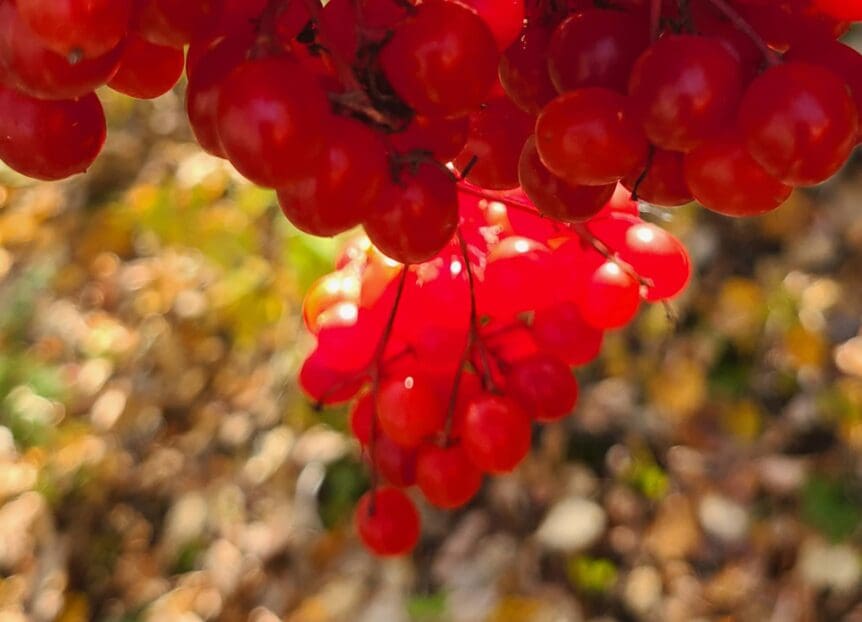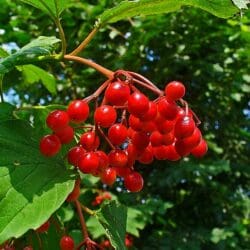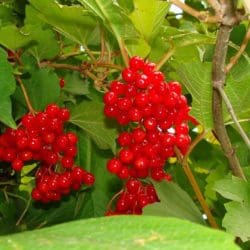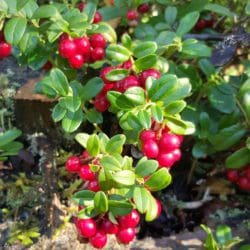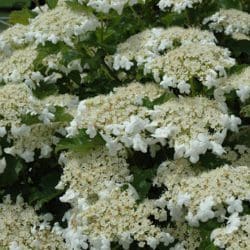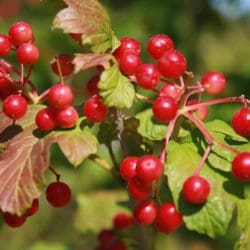Hardy Fruit for Zone 2 Gardens
The American Highbush Cranberry grows wild in Alberta. It is found around lakes, in shady forest glens, and along forgotten streams that flow in the spring. You’ll smell them on the breeze before you see them. They have a distinct aroma, vaguely reminiscent of blue cheese or more likely – “stinky socks”! The fruit grows in big clusters of juicy red berries! Actually, even though this plant is not a true cranberry, its fruit, or ‘drupes’ as they are known to botanists, strongly resemble cranberries in both appearance and taste. They make wonderful cranberry and apple jellies and are great for Thanksgiving turkey.
Highbush Cranberries mature in the September, the same as the cultivated cranberries. The highbush cranberry is a Viburnum, a member the Honeysuckle family. Around our region, where there are many settlers that came originally from the Ukraine, it is called Kalyna berry. The leaves turn beautiful shades of orange and red for the fall.
They taste like cranberries, and are super-sour before the frost. Real pucker-power! After the frost hits them, they lose their tannic pungency and become sweeter. The freshwater bog cranberry that we all know well, are less astringent. There is another alternative, which is also native to Alberta. The bog cranberry, is a Vaccinium, a member of the Ericaceae—Heather or Blueberry—family. Various cultivars are also known as Lingonberry!
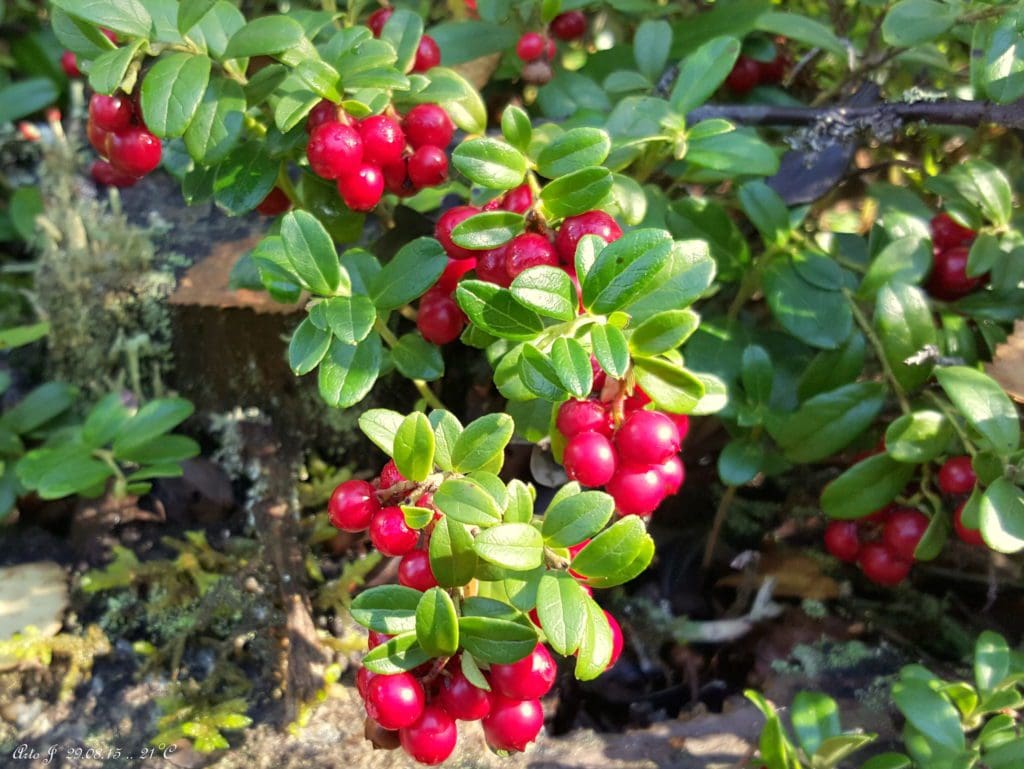
Red Candy Lingonberry
Cranberries are known to be a cure for colds and sore throats, are the ideal preventative juice for staving off urinary tract infections. They are high in manganese and antioxidants, and are a decent source of magnesium, which are good for your heart. They lower blood pressure and improve cholesterol.
The birds also love them – and they are a great source of food for them in the late fall and early winter. They offer a festive red glimmer among the bare branches through Christmas and beyond. No other sight is more quintessentially Ukrainian. No other plant has richer symbolic meaning.
Plant Description
Highbush Cranberry grows in hardiness Zones 2 through 7. It is a large and hardy deciduous shrub with a moderate growth rate of up to 1 foot per year, this big water-loving plant is typically 10 to 15 feet tall by 8 to 10 feet wide, with arching stems and a very dense, rounded form, making it a popular landscaping choice for use as a screening hedge. For a solid screen, plants should be spaced 2 to 3 ft. apart.
It is noted for attracting wildlife – of all kinds! The moose consider it a winter branch staple, and the birds which benefit from the fruit, which can remain on the branches well into mid winter. It is tolerant of frost, likes sun or semi-shade, and is successful in most soil types but does best in well-drained, moist soil that is rich and loamy. Established plants can tolerate drought, but they are helped by supplemental watering during such periods. Their leaves that are similar to many maple leaves, but have a somewhat wrinkled surface and impressed venation. They are glossy dark green in the summer but often change to yellow-red or red-purple in the fall.
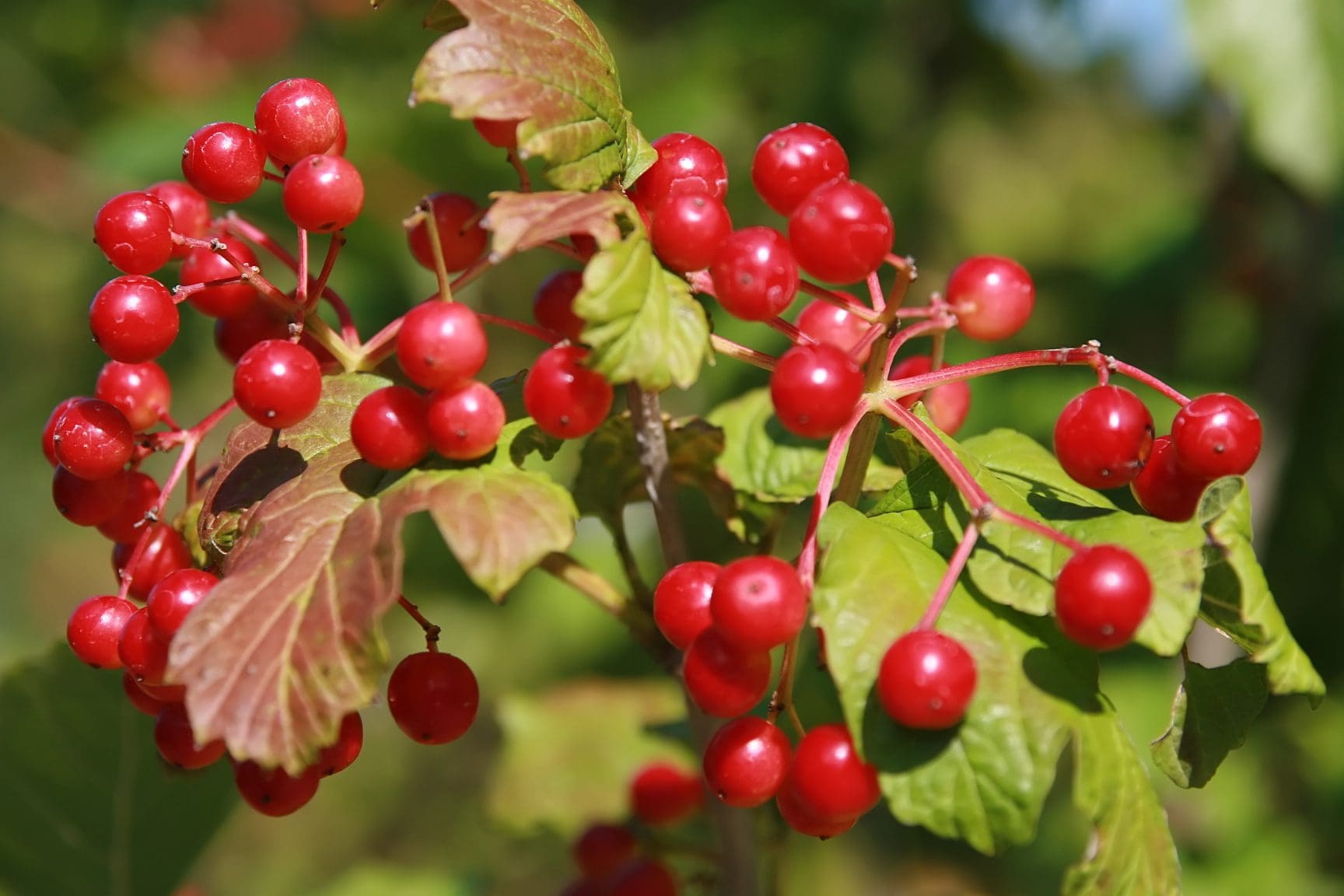
American Highbush Cranberry
Pollination and Flowers
It produces flat-top clusters of showy white flowers in June, after risk of frost has past. The clusters are 2 to 3 inches across, with an outer ring of larger, sterile flowers. The flowers are hermaphrodite (having both male and female organs), and are therefore self-fertile, so there is no need for a second type (or even a second individual plant) to provide pollen and produce fruit. The flowers are pollinated by both wind and insects.
Fruit
Nearly round drupe (drupe: a fleshy fruit with a central stonelike core containing one or more seeds) about 1/3 inch diameter with a single large seed, bright red, juicy and quite acid, like a cranberry. The seeds ripen from August to September. It does not begin to produce fruit until approximately five years of age. You will know when they start to ripen – they smell a lot like stinky socks!
Edible Qualities
The fruits/drupes can be eaten raw (they are very sour and not very tasty that way) or cooked, and like cranberries, they are rich in vitamin C and so have a tart, acid taste (the taste is best after a frost and when picked slightly under-ripe). They are excellent dried – craisons! They are usually so plentiful in the fall that its easy to miss them! If you wait just one week too long, the birds will have snapped every one up!
They are an excellent substitute for true cranberries and are likewise used in preserves, jams/jellies, sauces, etc., which make delicious condiments for meat and game. The jam has a very pleasant flavor. We like to mix it with crabapple juice to make a delectable jelly. ‘Wentworth’ and ‘Bailey’s Dwarf are half-high Dwarf American cranberry varieties that are examples of the better-tasting, American form (americanum) versus the European form (see note below).
Alaska Highbush Cranberry – A hard-to-come-by variety, Alaska is an extremely hardy to zone 0, highbush cranberry that produces an abundance of tasty bright red berries. Its claim to fame is the quite large fruit, which is best suited for jams, jellies, and preserves. Alaska is also very attractive as a bush, flowering with large white pinwheel blossoms in the spring, and is commonly used in hedges. Self-fertile, though a second plant is recommended for increased yields. Mature Size: 10′ tall by 8′ wide
Compact Highbush Cranberry Varieties
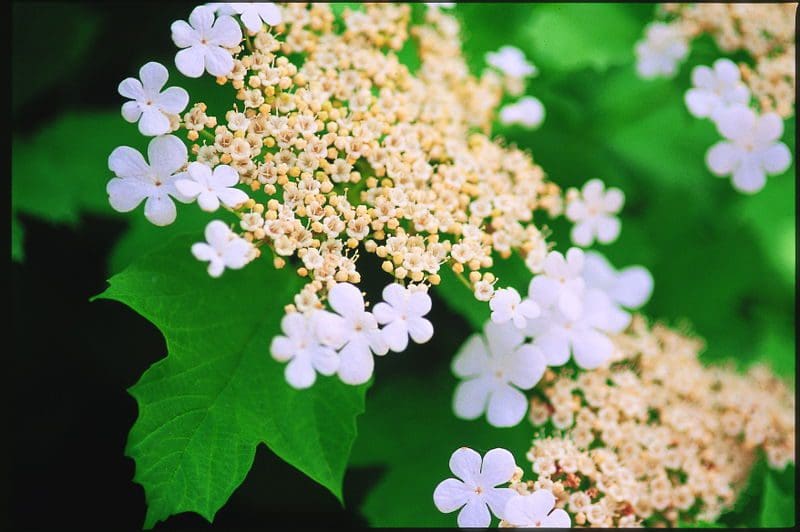
Wentworth Cranberry – Photo courtesy Bron
Wentworth Compact Highbush Cranberry – This is a more handsome variety than the native Highbush Cranberry. The “American” Cranberry variety ‘Wentworth’ has a flowery spring show, three-lobed glossy-green leaves in summer, cranberry-red fruit and nice fall color. Its claim to fame is it’s nice rounded habit works as a single specimen alone or in the shrub border but also shines as a hedge. Planted 2-3′ apart they’ll become a hedge that has interest throughout the season. You can keep them dense with once-a-year trimming after they flower.
Baileys Compact Highbush Cranberry – These plants are considerably smaller and tidier, a truly compact version of the highbush cranberry. They grow 6’ tall x 5’ wide. The plants have showy white lacecap flowers held at the top of branches in June to early July. They also produce an abundance of magnificent scarlet cranberries from ready to pick by mid-September, after the first frost. They have attractive maple shaped leaves, which start out brick red in spring.
Dwarf European Cranberry *Please Note: There is a European form (species or possibly subspecies) of highbush cranberry (Viburnum opulus) known as the Dwarf European Cranberry, that has inedible/bitter fruit. If you wish to eat the fruit, make sure you plant the true North American species, Viburnum opulus var. americanum. You will often see “highbush cranberry” listed for sale under its old name, Viburnum trilobum, so many people have had the unfortunate experience of discovering that what they purchased was the European form when they were hoping for the American form.
Bog Cranberries or Lingonberries
Lingonberries are often called cowberries, lowbush cranberries, or whortleberries. These berries are closely related to cranberries and blueberries, producing large amounts of small red berries with a flavor similar to cranberries. These berries are much sweeter and have virtually no astringency.
They’re a low-growing perennial plant that grows on a woody shrub that grows 12-16 inches high, and spreads through underground runners or seeds. These plants spread an average of 9 to 12 inches during the first few years after planting.
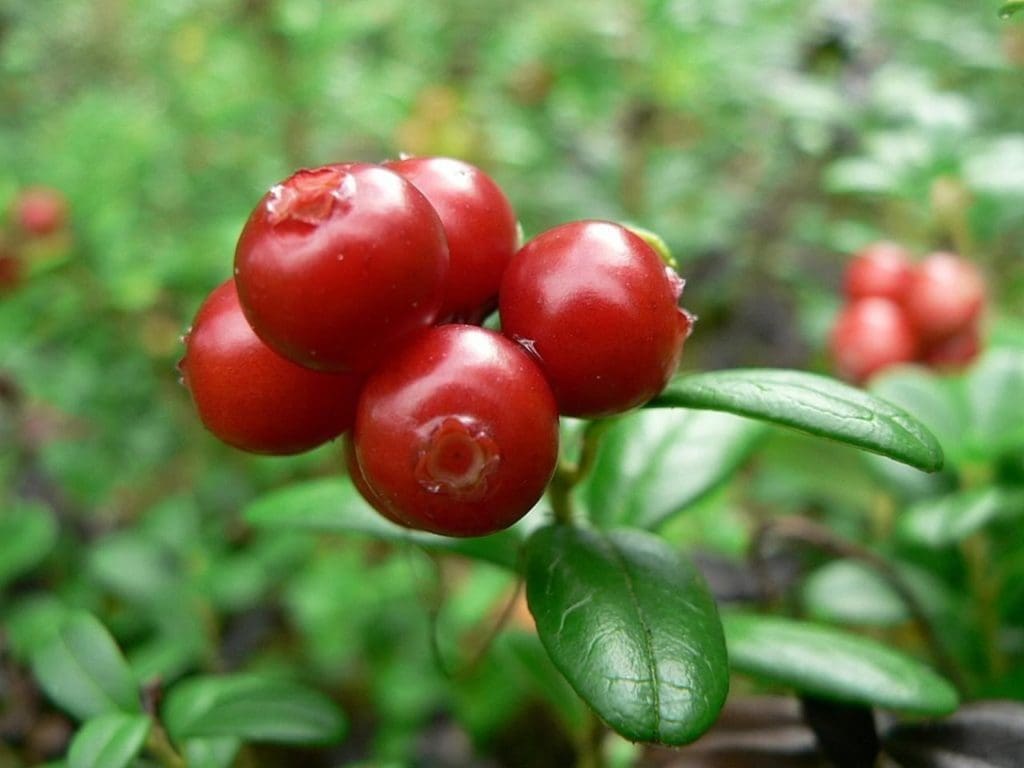
Koralle Lingonberry
Where Do Lingonberries Grow?
Unlike many other berries, lingonberries thrive in cold temperatures. The plants are known to survive in temperatures as low as -50℉, and they require a minimum 800 chill hours to produce berries. Those chill hour requirements are the same for most blueberry varieties, which also require cool winters and a dormant period to thrive.
Where To Plant Lingonberries
- Lingonberry plants grow best when you pick a location with full sunlight; these plants enjoy ample sunlight, averaging six to eight hours per day. They also grow well in partial shade, but full sunlight encourages larger crops.
- One thing that is different about lingonberry plants is that they prefer to grow in very acidic soil. Before planting, it’s best to check your current pH range and adjust however you need. These plants grow best with a soil range between 4.2 to 5.2. If your soil is too neutral or alkaline, garden sulfur is one way to lower the pH range. Our soil PH in in Edmonton is usually around 7 (neutral). You will need to add about 12” of peatmoss to your planting zone to bring the PH down to 4.5.
- Before planting, you have to prepare your garden beds, turning the soil to a depth of 6-12 inches. These plants prefer to grow in fluffy, loose soil, free of any rocks or debris that might block the root growth.
- I typically use a soil mix that is a blend of compost, peat moss, and sand. In this case, peat moss will make the dirt more acidic, precisely what your plants want for ideal growth. Another option is to use pine bark mulch, which increases the acidity in your soil.
- The best time to plant lingonberries is in the spring, after the danger of frost has passed. They grow in Canadian Hardiness Zones 2-6. These plants originate in the cold climates of the North, stretching throughout the Scandinavian countries. So, if you have cold winters, don’t worry; these plants handle it.
Pollination
You only have to grow one plant because these are self-pollinating, but growing two plants or two varieties will help increase the size of your berries and produce a higher yield.
Lingonberry Plant Care
Once your lingonberry plants are growing in your garden, learning how to take proper care of them is essential. Keeping your plants well-watered is crucial, especially during the primary growing season and dry spells. Lingonberry plants require one to two inches of rain per week when they are in their growth season. Once the plant is established, you can decrease the needed water by half, but consistency is the most crucial watering part.
Most gardeners prefer to use a drip or soaker hose irrigation system because it delivers water at the soil level. If you water your plants (any plants really) overhead, you increase the risk of diseases. Ensure water during the early mornings to give the foliage time to dry off before the heat of the day.
You shouldn’t prune these vine-like bushes in the first five years except for removing dead branches. Remove flowers in the first year to strengthen their growth; this tells the plant to stop focusing on fruiting and keep growing. When you reach the sixth year of growth, cut back, leaving only the most vigorous canes in the early spring. That will keep your plants growing well for years to come.
As fall and winter approaches, stop watering as early as September unless the soil is extremely dry. You want to send the plants into dormancy and apply a thick layer of mulch when the ground freezes in the fall to prevent root damage. Root damage is common in areas that experience regular freezing and thawing cycles throughout winter.
Harvesting Lingonberries
Lingonberries produce two harvests: late summer and early fall. As the plants begin to grow berries and ripen, you should cover the bushes with bird netting but keep the net off the berries. Birds love to munch on these berries; who can blame them? Wait until your berries are firm and fully red before ripening. The best way to pick lingonberries is by hand or with a blueberry rake that’s also commonly used to collect wild blueberries. It’s often a tedious harvest since the berries are small, but a rake really speeds up the process. The berries ripen over several weeks, with different varieties ripening at intervals over the fruiting season.
Once harvested, it’s best to store them between 32-40℉ (in the refrigerator). Unlike other berries, these store for 8 to 12 weeks in the refrigerator, so you don’t have to rush to use or freeze them.
They also freeze well for later use. I typically freeze all of my lingonberries in a single layer on a baking sheet and then transfer them to a plastic bag. Then, when all of the berries are harvested, and the plants stop producing, I use them to make different recipes.
Order Yours Today!
-
Hahs Highbush Cranberry
$34.95 Read more -
Lingonberry Red Candy
$24.95 Read more -
Bailey Compact Amer. Cranberry
Price range: $19.95 through $54.95 Select options This product has multiple variants. The options may be chosen on the product page -
American Highbush Cranberry
Price range: $19.95 through $54.95 Select options This product has multiple variants. The options may be chosen on the product page

